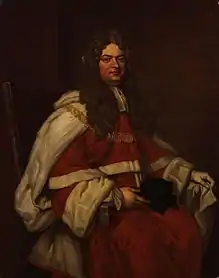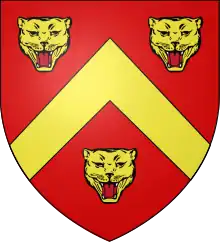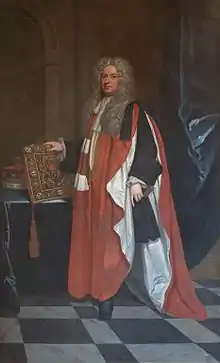Thomas Parker, 1st Earl of Macclesfield
Thomas Parker, 1st Earl of Macclesfield, PC, FRS (23 July 1666 – 28 April 1732) was an English Whig politician who sat in the House of Commons from 1705 to 1710. He was Lord Chief Justice from 1710 to 1718 and acted briefly as one of the regents before the arrival of King George I in Britain. His career ended when he was convicted of corruption on a massive scale and he spent the later years of his life in retirement at his home, Shirburn Castle in Oxfordshire.
The Earl of Macclesfield | |
|---|---|
 Portrait after Sir Godfrey Kneller (1712). | |
| Lord High Chancellor of Great Britain | |
| In office 12 May 1718 – 7 January 1725 | |
| Monarch | George I |
| Preceded by | The Lord Cowper |
| Succeeded by | In Commission |
| Personal details | |
| Born | 23 July 1666 Staffordshire, England |
| Died | 28 April 1732 (aged 65) |
| Occupation | Politician |

Early life
Parker was born in Staffordshire, the son of Thomas Parker, an attorney at Leek and his wife Anne, daughter of Robert Venables of Nuneham, Cheshire. He was educated at Adams' Grammar School at Newport, Shropshire, Derby School in 1680 and at Rev. Samuel Ogden's school at Derby. He was admitted at Inner Temple in 1684 and at Trinity College, Cambridge in 1685.[2] On 23 April 1691, he married Janet Carrier, whose sister was married to William Anson, 1st Baron Anson's father. He was called to the bar in 1694.[3]
Political career
Parker was returned as Whig Member of Parliament for Derby at the 1705 English general election and was appointed QC and serjeant-at-law and knighted on 9 July 1705. He was returned unopposed for Derby at the 1708 British general election. Like other Whigs, he voted for the general naturalization of foreign Protestants in 1709. Being one of the leading Whig lawyers in the House of Commons, he was deeply involved in the moves to impeach Dr Sacheverell. He was appointed to the committee to draw up the articles of impeachment on 14 December 1709. The committee was later given the management of the trial. In 1710 he refused the office of Lord High Chancellor of Great Britain, but was made a Privy Counsellor. The office of Lord Chief Justice fell vacant in 1710 and the administration wanted a quick replacement. Parker was appointed on 11 March 1710 and vacated his seat in the House of Commons.[3]
Lord Chief Justice

From 1710 to 1718 Parker was involved in the prosecution of Dr Sacheverell. He made a vehement attack on Sacheverell and the high church clergy. He defended Whig propagandists and harried Tory publicists, including Defoe and Swift, on the slightest suspicion of favouring the Pretender. He spoke against the peace in the Privy Council in April 1713. In June 1714 he was given evidence of the recruiting activity of Jacobite agents which resulted in a price being placed on the Pretender's head.[3] On 1 August 1714, Queen Anne died, and her successor, King George I, was in Hanover, so Baron Parker was designated as one of the regents of Great Britain, Ireland and the realms beyond the seas until the new monarch arrived in Britain. His support for the Hanoverian succession was appreciated by King George I who reappointed him lord chief justice in 1714, and raised him to the peerage as Baron Parker of Macclesfield in 1716, in which year he purchased, and then commenced to restore, Shirburn Castle in Oxfordshire, which was to be the seat of the house of Macclesfield for the next 300 years. In 1718, because the King could not speak English, Parker gave the King's Speech in the House of Lords.
Lord Chancellor
In 1718, Parker became Lord Chancellor, and was given a pension for life. In 1721, he was advanced to the title Earl of Macclesfield with the additional subsidiary title of Viscount Parker.
Impeachment
In 1724, Parker was implicated in financial irregularities, but he did not resign as Lord High Chancellor of Great Britain until 1725. In 1725, he was impeached and tried in the House of Lords. He was, unanimously, convicted of corruption for taking more than £100,000 in bribes (the equivalent of more than £11,000,000 today). He was fined £30,000 and placed in the Tower of London until payment was received. He was also struck off the roll of the Privy Council. He was a fabulously wealthy man, possibly because of his corruption, but as this money was confiscated, he had no resources to pay a fine. He spent most of the rest of his life at Shirburn Castle. He died in Soho Square, London on 28 April 1732 and was buried at Shirburn.[3]
Parker was elected a Fellow of the Royal Society in 1713. He was a friend of Bernard de Mandeville, whose satirical Fable of the Bees became highly controversial in the 1720s. He was patron of a grammar school built at Leek, his home town. In 1727 he was a pallbearer at the funeral of another friend, Sir Isaac Newton.
References
- Debrett's Peerage, 1968, p.723
- "Parker, Thomas (PRKR685T)". A Cambridge Alumni Database. University of Cambridge.
- "PARKER, Thomas (1667-1732), of Bridge Street, Derby, and Essex Street, London". History of Parliament Online. Retrieved 3 June 2019.
External links
- Manuscript reference
- 'everything' on-line reference
- document relating to his impeachment.
- How Much Is That Worth Today?
| Parliament of England | ||
|---|---|---|
| Preceded by John Harpur Thomas Stanhope |
Member of Parliament for Derby 1705–1707 With: Lord James Cavendish |
Parliament of Great Britain |
| Parliament of Great Britain | ||
| Parliament of England | Member of Parliament for Derby 1707–1710 With: Lord James Cavendish |
Succeeded by Lord James Cavendish Richard Pye |
| Legal offices | ||
| Preceded by Sir John Holt |
Lord Chief Justice of the King's Bench 1710–1718 |
Succeeded by Sir John Pratt |
| Political offices | ||
| Preceded by The Lord Cowper |
Lord High Chancellor of Great Britain 1718–1725 |
In commission Title next held by The Lord King |
| Honorary titles | ||
| Preceded by The Earl of Northampton |
Custos Rotulorum of Warwickshire 1719–1728 |
Succeeded by The Duke of Montagu |
| Peerage of Great Britain | ||
| New creation | Earl of Macclesfield 1721–1732 |
Succeeded by George Parker |
| Baron Parker 1714–1732 | ||
.svg.png.webp)

.jpg.webp)